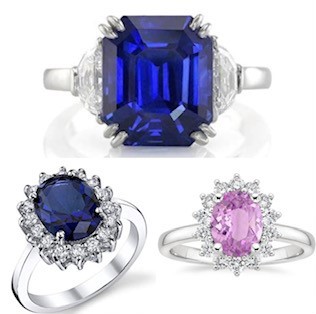Alternatives To Diamond Engagement Rings
- Holly Robinson

- Aug 16, 2019
- 2 min read
Diamond alternatives have become popular over the years and many of us now are swooning over the quirky designs and the unique beauty of natural gemstones.(Just think of the Katy Perry & Orlando Bloom Engagement this Valentines Day!)
When considering the perfect gemstone for an engagement ring whilst beauty ranks highly so too should wearability & durability.
My two top picks for 'Alternatives to Diamonds' would be Ruby & Sapphire as they offer a variety of colours and are known to wear extremely well over time.

Hardness
Diamond is one of the hardness materials used to make engagement rings and whilst they aren’t destructible knowing that the stone you have chosen to symbolise your love for another is hardwearing is a great bonus.
Sapphire & Rubies are your next best choice regarding wearability. Both being part of the corundum family these two boasts 9 on the MOH scale.
The MOH scale is used to measure the relative hardness of a mineral by its resistance to scratching.
The Science
Corundum is a form of Aluminium Oxide which typically contains traces of iron, vanadium and chromium. The family has two primary gemstone varieties Ruby & Sapphire.
Colours

Both Rubies & Sapphires are available in a variety of colours. Rubies are typically red due to the presence of chromium however Sapphires can exhibit a range of colours depending on which transition metal is present. Blue Sapphires will have both contain titanium & iron however, natural "fancy" sapphires can contain many trace elements that cause colours such as; yellow, purple, orange, and green along with "parti sapphires" that show two or more colours. The only colour that sapphire cannot be is red – as red coloured corundum is called Ruby. Pink coloured corundum may be either classified as ruby or sapphire depending on source location.
Sourcing Rubies & Sapphires
Significant amounts of Sapphire & Ruby are found in Eastern Australia, Thailand, Sri Lanka, China, Madagascar, East Africa and Northern American.
Every sapphire mine produces a wide range of quality, and origin is not a guarantee of quality. For sapphire, a sapphire sourced in Kasmir receives the highest premium, although Burma, Sri Lanka, and Madagascar also produce large quantities of fine quality gems.
Treating Gemstones
Some gemstones only require cutting and faceting to reveal their natural beauty however some stones require a little more attention and treatment.
A gemstone treatment refers to any process other than cutting and polishing that improves the appearance of a gemstone.
There are acceptable treatments used widely used across the jewellery industry so much so that they do not have to be disclosed and it should be readily assumed these treatments will have occurred. Examples of acceptable treatments include heat treatment and clear oiling or waxing.
However, there are some treatments that change the structure or colour of a gem by artificial means and are not permitted or must be disclosed at the point of sale. Examples of unacceptable treatments include infilling, laser drilling and surface or lattice diffusion.
At Holly Robinson Jewellery I will only source natural gemstones that have undergone standard treatments if necessary.
Celebrity Inspiration
With Holly Robinson Jewellery you can be sure to have the flexibility & freedom to create your own engagement ring unique to you both!


.png)

















Comments